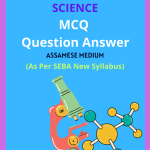Class 7 Science MCQ Chapter 14 Electric Current and its Effects Solutions in English Medium, Class 7 Science Multiple Choice Question Answer in English to each chapter is provided in the list so that you can easily browse throughout different chapters Class 7 Science MCQ Chapter 14 Electric Current and its Effects Notes and select need one.
Class 7 Science MCQ Chapter 14 Electric Current and its Effects
Also, you can read the SCERT book online in these sections Class 7 Science Objective Type Solutions by Expert Teachers as per SCERT (CBSE) Book guidelines. These solutions are part of SCERT All Subject Solutions. Here we have given Assam Class 7 Science MCQs Solutions in English for All Subject, You can practice these here.
Electric Current and its Effects
Chapter – 14
| MCQ |
1. The most suitable material for making the core of an electromagnet is:
(a) Iron.
(b) Brass.
(c) Aluminum.
(d) Steel.
Ans: (a) Iron.
2. Why is it convenient to use symbols for electric components?
(a) To save space and simplify circuit diagrams.
(b) To make the components heavier.
(c) To increase the number of components.
(d) To make circuits more complex.
Ans: (a) To save space and simplify circuit diagrams.
3. Circuit Breaker Device which can be used in place of fuse in domestic electric wiring is called:
(a) CBD.
(b) DCB.
(c) MCD.
(d) MCB.
Ans: (d) MCB.
4. What is the heating effect of current used for?
(a) To cool electric components.
(b) To generate magnetic fields.
(c) To produce heat in electrical devices.
(d) To create sound in appliances.
Ans: (c) To produce heat in electrical devices.
5. A current carrying wire produces:
(a) An electric field.
(b) A magnetic field.
(c) Both electric and magnetic fields.
(d) Neither electric nor magnetic field.
Ans: (b) A magnetic field.
6. What is the purpose of an electric fuse?
(a) To amplify electric current.
(b) To prevent fires and damage by melting and breaking under large currents.
(c) To increase voltage.
(d) To improve electrical conductivity.
Ans: (b) To prevent fires and damage by melting and breaking under large currents.
7. The sound produced in a door bell is due to the:
(a) Chemical effect of current.
(b) Heating effect of current.
(c) Magnetic effect of current.
(d) None of the above.
Ans: (c) Magnetic effect of current.
8. What does a current-carrying wire behave like?
(a) A conductor.
(b) A magnet.
(c) A semiconductor.
(d) An insulator.
Ans: (b) A magnet.
9. Which of the following characteristics is NOT suitable for a fuse wire?
(a) Thin and short.
(b) Thick and short.
(c) Low melting point.
(d) Higher resistance than rest of wiring.
Ans: (b) Thick and short.
10. What is an electromagnet made of?
(a) A coil of wire wrapped around a piece of iron.
(b) A coil of wire wrapped around a piece of copper.
(c) A permanent magnet.
(d) A piece of plastic with a current flowing through it.
Ans: (a) A coil of wire wrapped around a piece of iron.
11. Which are the two uses of electromagnets?
(a) Electromagnets are used in cranes, in steel works and scrapyards for lifting heavy loads.
(b) In hospitals dealing with eye injuries, electromagnets are used for removing iron splinters from the eyes.
(c) Both (a) and (b).
(d) None of these.
Ans: (c) Both (a) and (b).
12. Name the device which is used to make or break an electric circuit:
(a) Battery.
(b) Bulb.
(c) Wire.
(d) Switch.
Ans: (d) Switch.
13. Which of the following is the reason for excessive current in our houses?
(a) Direct touching of wires.
(b) Magnet.
(c) Both (a) and (b).
(d) None of the above.
Ans: (a) Direct touching of wires.
14. _________ piece is attracted by an electromagnet:
(a) Wood.
(b) Iron.
(c) Plastic.
(d) Rubber.
Ans: (b) Iron.
15. When electric current passes through a wire, it behaves like a magnet. This is the:
(a) Magnetic effect of current.
(b) Electrical effect of current.
(c) Heating effect of current.
(d) Optical effect of current.
Ans: (a) Magnetic effect of current.

Hi! my Name is Parimal Roy. I have completed my Bachelor’s degree in Philosophy (B.A.) from Silapathar General College. Currently, I am working as an HR Manager at Dev Library. It is a website that provides study materials for students from Class 3 to 12, including SCERT and NCERT notes. It also offers resources for BA, B.Com, B.Sc, and Computer Science, along with postgraduate notes. Besides study materials, the website has novels, eBooks, health and finance articles, biographies, quotes, and more.


